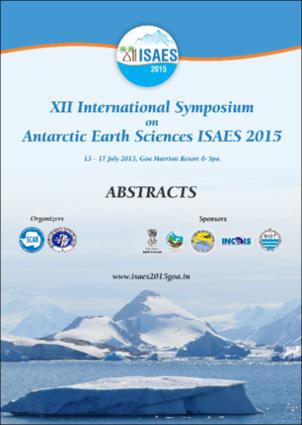- Repositorio Institucional INGEMMET
- Ponencias y Artículos científicos
- Ponencias, comunicaciones en congresos
Please use this identifier to cite or link to this item:
https://hdl.handle.net/20.500.12544/2670Weathering and geochemical dispersion in Almirantazgo Bay, Crepin point, Machu Picchu Peruvian Antarctic station: preliminary results
2015
XII International Symposium on Antarctic Earth Sciences ISAES 2015: 13-17 July, Goa, India. Abstracts
Global climate changes have a significant impact on the fragile ecosystems of Antarctica. These processes involve significant changes since the last glaciations, one product being exposure of areas with fracturing and weathering of rocks in Antarctica.The melting exposed surfaces of rocks, causing its disintegration due to physical or chemical and even organic processes; this decay involves the decomposition of minerals that are susceptible to these changes and tend to form new compounds. Undergoing environmental disturbances because of human disturbance, Antarctica is a suitable place to conduct a study on the geochemical characteristics of all elements present in the soil, which are closely related to the composition of the original rock. The preliminary reconnaissance and mapping of geological units were defined by Birkenmajer (1980) and subsequent work. Kraus et al., (2010) define regional geochemical characteristics and they related with paleomagnetism studies in across Almirantazgo Bay. Preliminary reconnaissance map in the Peruvian Antarctic Station was conducted by Palacios (1988) in the Antar II expedition; Geomorphological and stratigraphic units present were defined. Subsequent work performed in Crepin Point and vicinity were aimed at establishing the geotechnical characteristics (Fidel, 1991; Guzman, 1999; Pari & Zavala, 2000), mineralogical (Quispesivana, 1995; Aranda, 1997) and paleontological (Romero 2000; Morales 2002) they established and contributed the geological knowledge of Crepin Point. These studies recognized the presence of volcanic rocks, subvolcanic and intrusive nature that arise and are surrounded by glaciers. The volcanic rocks outcropping in the area are basaltic andesites and andesites. These are intruded by granodioritic intrusive rocks and subvolcanic dikes; both much younger. This process, where a young rock intrudes to an older, generates a chemical change in the contact zone of both bodies (Barnes, 1997). The changes are reflected when the original minerals, rocks both change their chemical composition and crystallizes under other conditions. Additional to this cooling process and product of magma, which produced both as intrusive volcanic rocks, begin to circulate fluids, high temperature, high salinity and saturated silica known under the name of hydrothermal fluid (Hedenquist and Lowenstern 1994) , staying in host rocks through fractures and minerals precipitate to form associations and are commonly called veins. Both processes produce changes in rocks and alteration zones are called. The correct identification and characterization of alteration zones allows us to delineate areas with different geochemical behavior and having major implications in the formation of soils and in the water system around them. Studies in sediments in Admiralty Bay and around the permanent scientific stations (Santos et al., 2005; Santos et al., 2007; Ribeiro et al, 2011; Sun et al, 2003) show concentration of As, Cd, Cr, Cu, Ni, Pb and Zn; which are associated, probably permanent human activity in these sectors. However the Antarctic Scientific Machu Picchu station is occupied temporarily during the austral summer, which significantly reduces the influence of human beings on the environment. During the expedition Antar XXII (2013-2014) and Antar XXIII (2014-2015) geological mapping of a sector Crepin Point were conducted and maps were upgraded, further representative samples of stratigraphic units in the area and some surrounding areas to Machu Picchu Scientific Station were taken; where anomalous values of Cu, Mn, As, etc. detected, however spatial distribution of the elements of this area is yet to be defined, which is included the current work for this year.
The Scientific Committee on Antarctic Research
Files in This Item:
| File | Description | Size | Format | |
|---|---|---|---|---|
| Cerpa-Weathering_and_geochemical_dispersion.pdf | Resumen de póster | 773.67 kB | Adobe PDF | View/Open |
This item is licensed under a Creative Commons License












